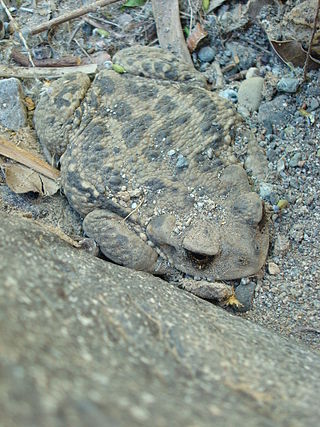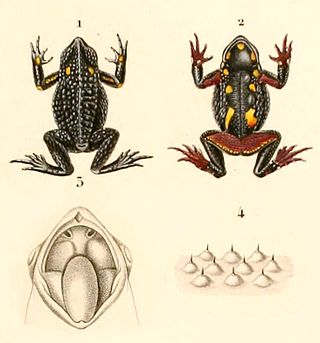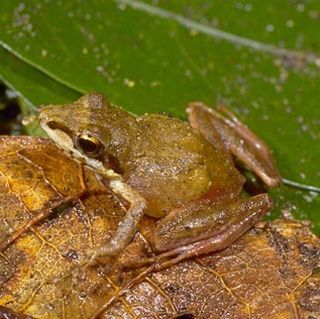Rhinella rostrata, also known as the Mesopotamia beaked toad, is a species of toad endemic to Colombia. It is only known from its type locality near the village of Mesopotamia, on the western slope of the Cordillera Occidental in the south of the Antioquia Department.

Rhinella achalensis is a species of toad in the family Bufonidae that is endemic to northern Argentina.
Rhinella amboroensis is a species of toad in the family Bufonidae that is endemic to the region of its type locality in the Carrasco Province of Bolivia and the adjacent Santa Cruz Department. Its common name is Cochabamba toad. It may exist in the Carrasco National Park and/or Amboró National Park, depending on its exact range.

Rhinella arunco is a species of toad in the family Bufonidae that is endemic to Chile. Its natural habitats are subtropical or tropical dry shrubland, rivers, intermittent rivers, freshwater marshes, intermittent freshwater marshes, water storage areas, ponds, aquaculture ponds, open excavations, and irrigated land. It is threatened by habitat loss.
Rhinella fissipes, the Carabaya toad, is a species of toad in the family Bufonidae that is found in Bolivia and Peru. Its natural habitats are subtropical or tropical moist montane forests, rivers, freshwater marshes, and intermittent freshwater marshes.
Rhinella quechua is a species of toad in the family Bufonidae. It is endemic to Bolivia. Its natural habitats are subtropical or tropical moist montane forests, rivers, freshwater marshes, and intermittent freshwater marshes. It is threatened by habitat loss.
Rhinella rubropunctata is a species of toad in the family Bufonidae that is found in southern Chile and Argentina. Its natural habitats are humid to xeric temperate forests and open environments. It tolerates a certain degree of disturbance. Breeding takes place in shallow temporary ponds near rivers, reservoirs and lakes. It is threatened by habitat degradation and fragmentation.
Rhinella sclerocephala is a species of toad in the family Bufonidae. It is endemic to the Sierra de San Luis in the Falcón state, Venezuela. Its natural habitats are cloud forests at elevations of 1,150–1,500 m (3,770–4,920 ft) asl. Its habitat is under strong pressure from agriculture and livestock farming, even within the Juan Crisóstomo Falcón National Park.

Rhinella spinulosa is a species of toad in the family Bufonidae that is found in the Andean Argentina, Bolivia, Chile, and Peru.

Rhinella sternosignatus is a species of toad in the family Bufonidae. It is found in Colombia and Venezuela. Its natural habitats are subtropical or tropical moist lowland forests, subtropical or tropical moist montane forests, rivers, freshwater marshes, and intermittent freshwater marshes. It is threatened by habitat loss.
Rhinella vellardi, the Alto Marañon toad, is a species of toad in the family Bufonidae that is endemic to Peru. It is only known from the type locality in the upper Marañón area, Cajamarca Region of northern Peru. Its natural habitat is montane forest in the upper Amazon basin. It is a rare species of which little is known.

Wright's mountain tree frog is a species of frog in the family Hylidae found in Mexico and the United States. Its natural habitats are temperate forests, temperate grassland, rivers, and freshwater marshes. Dryophytes wrightorum has been regarded as a synonym of Dryophytes eximius, the mountain tree frog, which is listed as the state amphibian of Arizona. As presently circumscribed, Dryophytes eximius is endemic to Mexico and does not occur in Arizona. It is the state amphibian of Arizona.
Gastrotheca espeletia, also known as the north shore marsupial frog is a species of frog in the family Hemiphractidae. It is found in Colombia and Ecuador. Its natural habitats are subtropical or tropical moist montane forests, subtropical or tropical high-altitude shrubland, subtropical or tropical high-altitude grassland, rivers, freshwater marshes, and intermittent freshwater marshes. It is threatened by habitat loss.

Blommersia grandisonae is a species of frog in the family Mantellidae first described by Jean Marius René Guibé in 1974. It is endemic to Madagascar.
Ptychadena christyi is a species of frog in the family Ptychadenidae. It is found in Democratic Republic of the Congo and Uganda. Its natural habitats are subtropical or tropical moist lowland forest and intermittent freshwater marshes.
Ptychadena erlangeri is a species of frog in the family Ptychadenidae. It is endemic to Ethiopia.
Ptychadena nilotica is a species of frog in the family Ptychadenidae. It is found in the upper reaches of the Nile and its major tributaries in Egypt, Sudan, South Sudan, Ethiopia, Burundi, Rwanda, Uganda, Kenya, Tanzania, Democratic Republic of Congo, and possibly Djibouti, Eritrea, and Somalia. Its natural habitats are wetlands near rivers, large lakes, swamps, and freshwater marshes and springs., as well as dry savanna, subtropical or tropical dry shrubland, arable land, irrigation canals and ditches.






